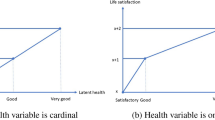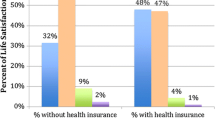Abstract
We test whether preferences over different well-being domains significantly correlate with life satisfaction. A sample of respondents is asked to simulate a policymaker decision consisting in allocating hypothetical financial resources among 11 well-being domains. We find that the willingness to invest more in the economic well-being domain is negatively correlated with life satisfaction. We argument that this evidence, while not excluding other rationales, is consistent with the utility misprediction hypothesis suggesting that individuals make systematic errors in estimating the well-being implied from their choices. Subsample estimates document that the less educated are more affected by the problem.



Similar content being viewed by others
Notes
Downloadable at http://www.stiglitz-sen-fitoussi.fr/documents/rapport_anglais.pdf.
The complete list of the 134 specific indicators created in the different BES domains by ISTAT is attached in ESM Appendix A. For a more complete and detailed information on the process of BES creation see the English version of the ISTAT/BES official website: http://www.misuredelbenessere.it/index.php?id=48.
With subjective wellbeing indicators we may have the paradox of individuals who behave as “happy slaves” reducing aspirations to the low level of their achievements, thereby lacking of desire for social progress. Sen illustrates the point by arguing that “The defeated and the downtrodden come to lack the courage to desire things that others more favourably treated by society desire with easy confidence” (Sen 1985: 15).
Subjective indicators occupy in the BES only one of the 12 domains (n.8 subjective wellbeing) while few subjective indicators are included to complement objective indicators in some selected domains (i.e. those of economic wellbeing, health, safety) (for further details see ESM Appendix A and B). Note as well that, in spite of its limits and potential manipulations, subjective wellbeing worth being measured since satisfaction/lack of satisfaction with life is highly likely to have repercussions on objective indicators such as health, social capital and political stability.
Messaggero, has a reputation of moderate conservative political orientation and is the fifth most red Italian newspaper (excluding sport newspapers).
Avvenire, is the most important Italian catholic newspaper. As such it reflects the ideological divide of Italian believers which are equally divided between right and left wing orientation.
Unità has a left wing tradition being the official newspaper of the Democrat Party.
These are Forum Nazionale Terzo Settore, FQTS, ARCI, ConVol, CSV Net, Labsus, Dignità del lavoro, Auser, Avis, Anpas, Bandiera Gialla, La perfetta letizia, Mondo alla Rovescia, Confini online, Il Metapontino.it, ARCI, Campania, Blog vitobiolchini, Domos (domotica sociale).
An inescapable limit of our online survey is that it is not representative of the Italian population. Online compilation in fact automatically selects a subsample of individuals who tend to be relatively younger and more educated than average. This limit is at the same time an interesting aspect of our survey since the composition of our sample anticipates characteristics of the future population which is bound to be more educated in the future. Also for this reason we may have a specific interest in investigating the relationship at stake in this specific group of the population. From another point of view lack of representativeness of our sample with respect to the Italian population is a common characteristics of many econometric studies which are not interested in descriptive traits of the universe of reference but to econometric links in that specific sample. Last but not least, subsample estimates for high/low educated respondents help us to correct the bias and to understand what happens in the subsample of the less educated which is closer to country average characteristics. We also correct our main estimates for non-representativeness of our sample with specific design weights described in section A4.4 of ESM Appendix A.
Note that the survey question changes when we ask preferences about subdomain specific indicators (from the simulation of an invested sum to an more general indication of priorities). This is because some of these indicators are subjective and it is not clear whether others may be affected by government expenditure (see ESM Appendix B).
Using self-declared levels of life satisfaction as a proxy for individual utility is a standard approach in the literature on subjective well-being and happiness economics [see, e.g., Frey and Stutzer (2002), Layard (2005), Di Tella and MacCulloch (2006) and Stutzer and Frey (2010), as well as in psychology (e.g., Kahneman et al. 1999; Diener et al. 1999). As is well known alternative subjective wellbeing measures are of affective (negative/positive affect) and eudaimonic (evaluation of the sense of one’s own life) type. The cognitive measure we adopt is however probably the most widely used at least in the economic literature on life satisfaction.
References
Bartolini, S., Bilancini, E., & Pugno, M. (2013a). Did the decline in social capital decrease american happiness? A relational explanation of the happiness paradox. Social Indicators Research, 110(3), 1033–1059.
Bartolini, S., Bilancini, E., & Sarracino, F. (2013b). Predicting the trend of well-being in Germany: How much do comparisons, adaptation and sociability matter? Social Indicators Research, 114(2), 169–191.
Becchetti, L., Corrado, L. and Fiaschetti, M. (2013). The heterogeneity of wellbeing “expenditure” preferences: evidence from a simulated allocation choice on the BES indicators, CEIS Research Paper N. 297.
Becchetti, L., Pelloni, A., & Rossetti, F. (2008). Relational goods, sociability, and happiness. Kyklos, 61(3), 343–363.
Burroughs, J. E., & Rindfleisch, A. (2002). Materialism and well-being: A conflicting values perspective. Journal of Consumer Research, 29(3), 348–370.
Campbell, A. (1981). The sense of well-being in America: Recent patterns and trends. New York: McGraw-Hill.
Carson, R. T., Flores, N. E., & Meade, N. F. (2001). Contingent valuation: Controversies and evidence. Environmental and Resource Economics, 19, 173–210.
Cohen, P., & Cohen, J. (1996). Life values and adolescent mental health. Mahwah: Lawrence Erlbaum.
Di Tella, R., Haisken-DeNew, J. P., & MacCulloch, R. (2010). Happiness adaptation to income and to status in an individual panel. Journal of Economic and Behavior Organization, 76(3), 834–852.
Di Tella, R., & MacCulloch, R. (2006). Some uses of happiness data in economics. Journal of Economic Perspectives, 20(1), 25–46.
Diener, E., Suh, E. M., Lucas, R. E., & Smith, H. L. (1999). Subjective well-being: Three decades of progress. Psychological Bulletin, 125(2), 276–303.
Easterlin, R. A. (2001). Income and happiness: Towards a unified theory. Economic Journal, 111(473), 465–484.
Easterlin, R. A. (2005). A puzzle for adaptive theory. Journal of Economic Behavior and Organization, 56(4), 513–521.
Frank, R. H. (1999). Luxury fever. Why money fails to satisfy in an era of excess. New York: Free Press.
Frey, B. S., Benz, M., & Stutzer, A. (2004). Introducing procedural utility: not only what but also how matters. Journal of Institutional and Theoretical Economics, 160(3), 377–401.
Frey, B. S., & Stutzer, A. (2002). What can economists learn from happiness research? Journal of Economic Literature, 40(2), 402–435.
Frey, B. S., & Stutzer, A. (2005). Does the political process mitigate or accentuate individual biases due to mispredicting future utility? In E. McCaffery & J. Slemrod (Eds.), Behavioral public finance. New York: Russell Sage Foundation.
Frey, B. S., & Stutzer, A. (2013). Economics and the study of individual happiness. In S. A. David, I. Boniwell, & A. C. Ayers (Eds.), The oxford handbook of happiness (pp. 431–447). Oxford: Oxford University Press.
Frey, B. S., & Stutzer, A. (2014). Economic consequences of mispredicting utility. Journal of Happiness Studies, 15(4), 937–956.
Helliwell, J. F., & Putnam, R. D. (2004). “The social context of well-being” philosophical transactions, 359(1449). In F. A. Huppert, B. Kaverne, & N. Baylis (Eds.), The science of well-being (pp. 1435–1446). London: Oxford University Press.
Imbens, G. W. (2003). Sensitivity to exogeneity assumptions in program evaluation. American Economic Review, 93, 126–132.
Kahneman, D. (1999). Objective happiness. In D. Kahneman, E. Diener, & N. Schwarz (Eds.), Well-being: the foundations of hedonic psychology (pp. 3–25). New York: Russell Sage Foundation.
Kahneman, D., Diener, E., & Schwarz, N. (1999). Well-being: The foundation of hedonic psychology. New York: Russell Sage Foundation.
Karabati, S., & Cemalcilar, Z. (2010). Values, materialism, and well-being: A study with Turkish university students. Journal of Economic Psychology, 31(4), 624–633.
Kasser, T. (2002). The high price of materialism. Cambridge: MIT Press.
Kasser, T., Rosenblum, K. L., Sameroff, A. J., Deci, E. L., Niemiec, C. P., Ryan, R. M., et al. (2014). Changes in materialism, changes in psychological well-being: Evidence from three longitudinal studies and an intervention experiment. Motivation and Emotion, 38(1), 1–22.
Kasser, T., & Ryan, R. M. (1996). Further examining the American dream: Differential correlates of intrinsic and extrinsic goals. Personality and Social Psychology Bulletin, 22(3), 280–287.
Lane, R. E. (1991). The market experience. Cambridge: Cambridge University Press.
Layard, P. R. G. (2005). Happiness: lessons from a new science. New York: Penguin.
Lebergott, S. (1993). Pursuing happiness: American consumers in the twentieth century. Princeton: Princeton University Press.
Luhman, M., Hofmann, W., Eid, M., & Lucas, R. E. (2012). Subjective well-being and adaptation to life events: A meta-analysis. Journal of Personality and Social Psychology, 102(3), 592–615.
Oishi, S., Kesebir, S., & Diener, E. (2011). Income inequality and happiness. Psychological Science, 22(9), 1095–1100.
Oswald, A., & Powdthaveem, N. (2008). Does happiness adapt? A longitudinal study of disability with implications for economists and judges. Journal of Public Economics, 92(5–6), 1061–1077.
Pugno, M. (2013). Scitovsky and the income-happiness paradox. The Journal of Socio-Economics, 43, 1–10.
Richins, M. L., & Rudmin, F. W. (1994). Materialism and economic psychology. Journal of Economic Psychology, 15(2), 217–231.
Rindfleisch, A., Burroughs, J. E., & Denton, F. (1997). Family structure, materialism, and compulsive consumption. Journal of Consumer Research, 23(4), 312–325.
Rindfleisch, A., Burroughs, J. E., & Wong, N. (2009). The safety of objects: materialism, existential insecurity, and brand connection. Journal of Consumer Research, 36(1), 1–16.
Roberts and Clement. (2007). Materialism and satisfaction with over-all quality of life and eight life domains. Social Indicators Research, 82, 79–92.
Scitovsky, T. (1992) [1976]. The joyless economy. Oxford: Oxford University Press.
Sen, A. K. (1985). Well-being, agency and freedom: The Dewey Lectures 1984. Journal of Philosophy, 82, 69–221.
Sirgy, M. J. (1998). Materialism and quality of life. Social Indicators Research, 43(3), 227–260.
Stock, J., & Yogo, M. (2005). Testing for weak instruments in linear IV regression. In D. W. K. Andrews (Ed.), Identification and inference for econometric models (pp. 80–108). New York: Cambridge University Press.
Stutzer, A. (2004). The role of income aspirations in individual happiness. Journal of Economic Behavior and Organization, 54(1), 89–109.
Stutzer, A., & Frey, B. S. (2010). Recent advances in the economics of individual subjective well-being. Social Research: An International Quarterly, 77(2), 679–714.
Sugden, R. (2008). Capability, happiness, and opportunity. In L. Bruni, F. Comim, & M. Pugno (Eds.), Capabilities and happiness. Oxford: Oxford University Press.
Van Praag, B. M. S. (1993). The relativity of the welfare concept. In M. Nussbaum & A. K. Sen (Eds.), The quality of life (pp. 362–416). Oxford: Clarendon.
Acknowledgements
The paper is part of a research coordinated by Laboratorio RicercAzione from Formazione Quadri Terzo Settore and sponsored by Fondazione con il Sud. The authors thank all the scientific board of FQTS, ISTAT and Fondazione con il Sud for their support, Stefano Bartolini, Tommaso Proietti and Maurizio Pugno for comments and suggestions, Sante Orsini, Roberto Porciello, Fabiola Riccardini and Focusmarketing for their precious coordination and research assistance in building the online survey and providing relevant data. Finally we thank the newspapers Messaggero, Avvenire and Unità for hosting the survey.
Author information
Authors and Affiliations
Corresponding author
Electronic supplementary material
Below is the link to the electronic supplementary material.
Rights and permissions
About this article
Cite this article
Becchetti, L., Conzo, P. Preferences for Well-Being and Life Satisfaction. Soc Indic Res 136, 775–805 (2018). https://doi.org/10.1007/s11205-017-1566-8
Accepted:
Published:
Issue Date:
DOI: https://doi.org/10.1007/s11205-017-1566-8




